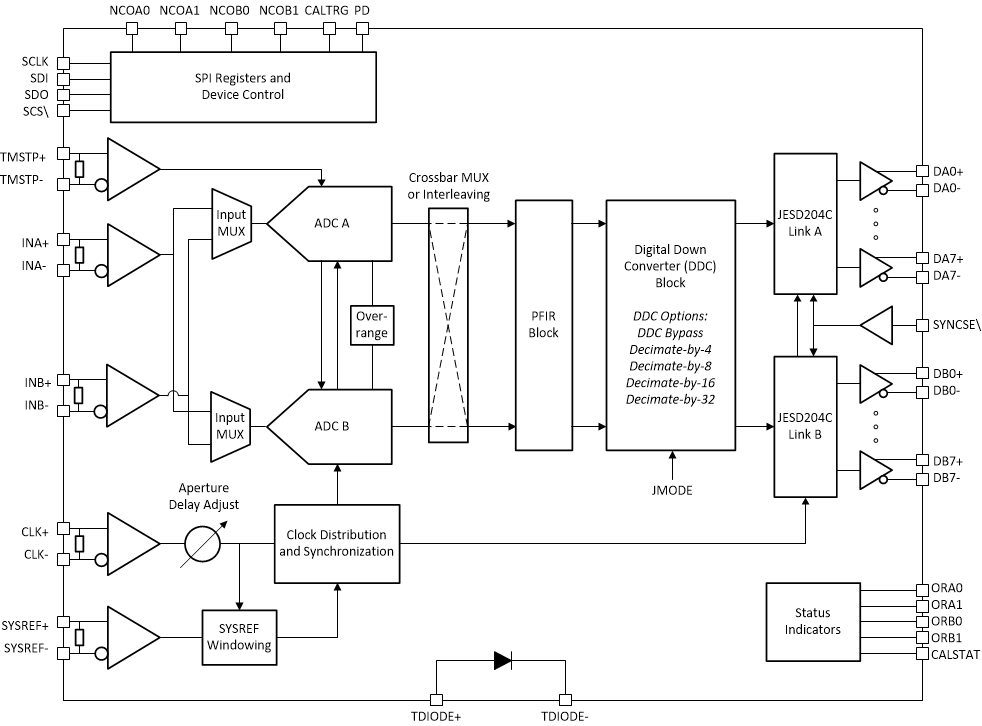JAJSEY1F April 2019 – June 2024 ADC12DJ5200RF
PRODUCTION DATA
- 1
- 1 特長
- 2 アプリケーション
- 3 概要
- 4 Pin Configuration and Functions
-
5 Specifications
- 5.1 Absolute Maximum Ratings
- 5.2 ESD Ratings
- 5.3 Recommended Operating Conditions
- 5.4 Thermal Information
- 5.5 Electrical Characteristics: DC Specifications
- 5.6 Electrical Characteristics: Power Consumption
- 5.7 Electrical Characteristics: AC Specifications (Dual-Channel Mode)
- 5.8 Electrical Characteristics: AC Specifications (Single-Channel Mode)
- 5.9 Timing Requirements
- 5.10 Switching Characteristics
- 5.11 Typical Characteristics
-
6 Detailed Description
- 6.1 Overview
- 6.2 Functional Block Diagram
- 6.3
Feature Description
- 6.3.1 Device Comparison
- 6.3.2 Analog Inputs
- 6.3.3 ADC Core
- 6.3.4 Temperature Monitoring Diode
- 6.3.5 Timestamp
- 6.3.6 Clocking
- 6.3.7 Programmable FIR Filter (PFIR)
- 6.3.8 Digital Down Converters (DDC)
- 6.3.9
JESD204C Interface
- 6.3.9.1 Transport Layer
- 6.3.9.2 Scrambler
- 6.3.9.3 Link Layer
- 6.3.9.4 8B/10B Link Layer
- 6.3.9.5
64B/66B Link Layer
- 6.3.9.5.1 64B/66B Encoding
- 6.3.9.5.2 Multiblocks, Extended Multiblocks and the Local Extended Multiblock Clock (LEMC)
- 6.3.9.5.3 Block, Multiblock and Extended Multiblock Alignment using Sync Header
- 6.3.9.5.4 Initial Lane Alignment
- 6.3.9.5.5 Block, Multiblock and Extended Multiblock Alignment Monitoring
- 6.3.9.6 Physical Layer
- 6.3.9.7 JESD204C Enable
- 6.3.9.8 Multi-Device Synchronization and Deterministic Latency
- 6.3.9.9 Operation in Subclass 0 Systems
- 6.3.10 Alarm Monitoring
- 6.4
Device Functional Modes
- 6.4.1 Dual-Channel Mode
- 6.4.2 Single-Channel Mode (DES Mode)
- 6.4.3 Dual-Input Single-Channel Mode (DUAL DES Mode)
- 6.4.4 JESD204C Modes
- 6.4.5 Power-Down Modes
- 6.4.6 Test Modes
- 6.4.7 Calibration Modes and Trimming
- 6.4.8 Offset Calibration
- 6.4.9 Trimming
- 6.5 Programming
- 6.6 SPI Register Map
- 7 Application Information Disclaimer
- 8 Device and Documentation Support
- 9 Revision History
- 10Mechanical, Packaging, and Orderable Information
パッケージ・オプション
メカニカル・データ(パッケージ|ピン)
- ZEG|144
- AAV|144
サーマルパッド・メカニカル・データ
発注情報
3 概要
ADC12DJ5200RF デバイスは、RF サンプリング、ギガ サンプルの A/D コンバータ (ADC) で、DC から 10GHz 超までの入力周波数を直接サンプリングできます。ADC12DJ5200RF はデュアル チャネル 5.2GSPS の ADC、またはシングル チャネル 10.4GSPS の ADC として構成できます。使用可能な入力周波数帯域が最高 10GHz であるため、L バンド、S バンド、C バンド、X バンドを直接 RF サンプリングでき、多様な周波数に対応したシステムを実現できます。
ADC12DJ5200RF は、最大 17.16Gbps のライン速度をサポートする最大 16 個のシリアル化されたレーンを備えた、高速な JESD204C 出力インターフェイスを使っています。JESD204C subclass-1 により、決定論的レイテンシおよびマルチデバイス同期をサポートしています。JESD204C インターフェイスは、ライン速度とレーン数との間でトレードオフのバランスを取るように構成できます。8b/10b と 64b/66b の両方のデータ エンコードをサポートしています。64B/66B エンコードでは、前方エラー訂正 (FEC) によるビット エラー率の改善をサポートしています。このインターフェイスは、JESD204B レシーバと下位互換性があります。
ノイズなしのアパーチャ遅延調整や、SYSREF ウィンドウ処理などの革新的な同期機能により、マルチ チャネル アプリケーションのシステム設計を簡素化できます。オプションのデジタル ダウン コンバータ (DDC) を使用すると、ベースバンドへのデジタル変換を実行でき、またインターフェイス速度を低減できます。プログラム可能な FIR フィルタにより、オンチップのイコライゼーションが可能です。
 ADC12DJ5200RF
ブロック図
ADC12DJ5200RF
ブロック図